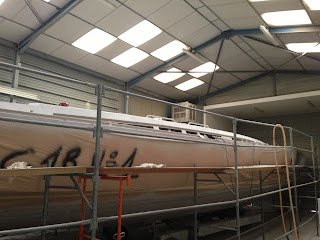This extract form on of the most famous La Fontaine's fable is well known, all french kids probably learned it. The difference is that, at Alubat, the Cigale is not completely abandonned yet and that work continues. The 'cold wind' definitely increases, but it has not destroyed everything yet. So, as I said in a previous posting, I went for a ride to the site to see the progress of work after a month of closure of summer. The hull and the various elements of the bridge are welded and the boat has entered the 'painting phase.' I already visited this workshop in the past but today it is getting too small. You almost have to squeeze yourself between the door frame and the the boat transom to enter. Looking at the bow, it almost touch the front door of the shop and you have get very thin to be able to tour the ship. Under these conditions, it is difficult to have an overview of 'the beast'. However I have done my best to get some shots 'seen from the ground.' |
|
Once on the bridge, looking from what will be the port helm, the 'landscape' changes a bit and you have an idea of what the helmsman will perceive when it comes to the size of the boat.
The 2 Cigale 16 I sailed seemed big on the water but there that's really impressive, even if the workshop walls distort sensation. The cockpit does not seem to be different from that of otherOVNIs and Cigales: the wooden benches are here, raised from the top of lockers with the handy storage compartement behind them. |
The companion way remains classic, compared to the OVNI Evolution 52 one but we are not on the same type of boat. From the bridge and going forward we discover the hatches and the space in which all ropes will travel from the mast to the cockpit so tha we will have a clear, unobstructed roof. Very visible too are the fillings at all angles of welded parts: air vents, handrails, various angles. After all those parts are polished (which is work intensive) the last painting activites will take place: undercoat, paint ...
|
There will be two large aft cabins I believe . Once the painting phase is completed, the interior design phase will begin: plumbing, electrical, engine, carpentry and a few other I forget while, outside, the installation of windows, deck panels , fittings, cockpit equipement etc. are the next steps.
It seems that on this model the rear frame so typical of ALUBAT won't exist. Probably it would have been too big.
I hope this building will continue until the boat is finished and ready to leave a pontoon and that in the mean time ALUBAT's order book will begins to fill, albeit slowly ... but surely.
 |
| Budapest Marathon, Octobre 2001: "Il était un petit navire, ..." |














Aucun commentaire :
Enregistrer un commentaire
Les commentaires aident à rendre le blog plus intéressant et à le faire évoluer: n'hésitez pas à commenter.
Merci.